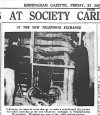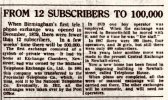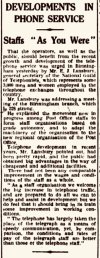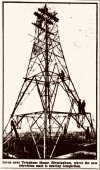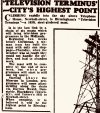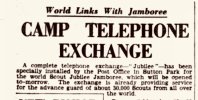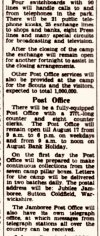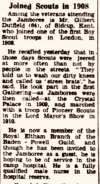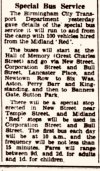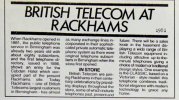-
Welcome to this forum . We are a worldwide group with a common interest in Birmingham and its history. While here, please follow a few simple rules. We ask that you respect other members, thank those who have helped you and please keep your contributions on-topic with the thread.
We do hope you enjoy your visit. BHF Admin Team
You are using an out of date browser. It may not display this or other websites correctly.
You should upgrade or use an alternative browser.
You should upgrade or use an alternative browser.
Telephone history: Telephone Service in Birmingham
- Thread starter Aidan
- Start date
RobT
Acemeccanoman
See here for working Strowger exchange & Fox & Goose game in Science Museum in Newhall Street.Does anyone remember the demonstration exchange at the Science Museum in Newhall Street ? A glass fronted cabinet with a dial telephone at each side, where you could dial from one side to the other, and watch the kit inside working. A lot of vertical / horizontal stepping relays (Strowger ?). A real exchange must have been a noisy place. I remember obtaining one of those relays, possibly from Hurst Street, and taking it apart to see how it worked, (but that is just me, happens with lots of my tech stuff even now).
Andrew.
"It will be noted that each suite commences with a cable turning section (C.T.S.), which, as its name implies, is necessary to turn the switchboard cables from the vertical run through the floor to the horizontal multiple along the switchboard. The C.T.S. is constructed of mahogany panelled to match the rest of the switchboard." from Telephony Vol. 1, J. AtkinsonWhat a lot of cable ! I guess this has significantly changed with changing technology.
In a manual telephone exchange wires from every subscriber had to be brought up to the switchboard (the 'multiple'). The wires for a given subscriber appeared at a socket at every third operator's position, ('multiple' appearances) so that by plugging to the left, ahead or the right the operator could reach every number on that exchange to make a call. Only a portion of calling lines appeared at a given operator's position though.
As long as we continue to have 'twisted-pair' copper wires from each subscriber wired back to the exchange there will be equivalent cables somewhere but they won't be going to the operators that remain in the system. They only need to be able to speak to a couple of subscribers and a supervisor and to send and receive signals from the switching system so the switchboard multiple as such is long gone.
RobT
Acemeccanoman
This I believe is from December 1930Later in February 1936 the Birmingham Gazette informs…
(the other exchanges may not need operators, but will need maintenance staff !)
View attachment 166828
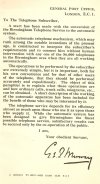
Pedrocut
Master Barmmie
Some other info from the 1930s concerning Telephone House…
April 1934 work began on foundations for Telephone House, completed December 1935.
January 1937 Neville Chamberlain officially opened Telephone House. Inside 239 miles of cable on and between switchboards: 631 miles of wire altogether. 5,600,00 soldered joints and 30,000 fuses.
Jan 1937 the first of the new coaxial type cables laid between London and Birmingham to yield 400 speech channels on each two pairs.
July 1937. Birmingham soon to become a television centre. The TV programmes will travel from Alexandra Palace to Birmingham along a 125 mile PO. coaxial cable from London Faraday to Telephone Home Birmingham.
April 1934 work began on foundations for Telephone House, completed December 1935.
January 1937 Neville Chamberlain officially opened Telephone House. Inside 239 miles of cable on and between switchboards: 631 miles of wire altogether. 5,600,00 soldered joints and 30,000 fuses.
Jan 1937 the first of the new coaxial type cables laid between London and Birmingham to yield 400 speech channels on each two pairs.
July 1937. Birmingham soon to become a television centre. The TV programmes will travel from Alexandra Palace to Birmingham along a 125 mile PO. coaxial cable from London Faraday to Telephone Home Birmingham.
Telephone House was still a TV centre in the 1970s, I could see the TV monitors from 95 Newhall Street. I recall being shown some 'co-ax', it looked like and was the size of gas flue liner with 'spiders' holding the core wire in the centre, (i.e. there was no solid dielectric).July 1937. Birmingham soon to become a television centre. The TV programmes will travel from Alexandra Palace to Birmingham along a 125 mile PO. coaxial cable from London Faraday to Telephone House Birmingham.
I expect by then the TV signals came up from London using microwave links. Perhaps the co-ax that I was shown just went to Sutton Coldfiend from Telephone House?
The newspaper article leaves out an important word - 'exchange', the 1949 link started at 'Museum', a telephone exchange. The London tower closed in 1967 when it was replaced by the nearby 'Post Office Tower'. The same thing happened in Birmingham of course.
"Technical Details
The pioneering nature of the link means much detailed information on the design is still available via papers published at the time.
Between London and Birmingham frequencies of 917 and 937 MHz were used, alternating for each "hop", with the reverse direction using 870 and 890 MHz. Initially the intermediate sites used a mast carrying a single antenna for each direction (Turners hill used two separate masts due to the acute angle between the two "lines of shoot". The terminal stations were equipped with 100 ft towers on the roof of the Post Office buildings with provision for two antennas. The equipment was installed in a building at roof level. At the intermediate sites, for "Part I", the equipment was installed in small brick buildings (to a standard Post Office design) but in "Part II" to minimise loss in the feeder cables the tower incorporated an equipment hut at the same level as the antennas. For "Part II" pairs of antennas were used on each side of the tower, allowing full two-way operation.
The antennas took the form of a parabolic reflector ("dish") 14 ft in diamater but with straight vertical sides to produce an effective width of 10 ft allowing a more compact mounting on the tower. The reflector consisted of horziontal tubes at approximately 1/4 wavelength (3") spacing. With a simple horizontal dipole at the focus of the dish a gain of 27.5 db was achieved." [From London - Birmingham 900MHz link]
"Technical Details
The pioneering nature of the link means much detailed information on the design is still available via papers published at the time.
Between London and Birmingham frequencies of 917 and 937 MHz were used, alternating for each "hop", with the reverse direction using 870 and 890 MHz. Initially the intermediate sites used a mast carrying a single antenna for each direction (Turners hill used two separate masts due to the acute angle between the two "lines of shoot". The terminal stations were equipped with 100 ft towers on the roof of the Post Office buildings with provision for two antennas. The equipment was installed in a building at roof level. At the intermediate sites, for "Part I", the equipment was installed in small brick buildings (to a standard Post Office design) but in "Part II" to minimise loss in the feeder cables the tower incorporated an equipment hut at the same level as the antennas. For "Part II" pairs of antennas were used on each side of the tower, allowing full two-way operation.
The antennas took the form of a parabolic reflector ("dish") 14 ft in diamater but with straight vertical sides to produce an effective width of 10 ft allowing a more compact mounting on the tower. The reflector consisted of horziontal tubes at approximately 1/4 wavelength (3") spacing. With a simple horizontal dipole at the focus of the dish a gain of 27.5 db was achieved." [From London - Birmingham 900MHz link]
DavidGrain
master brummie
I remember the All Figure phone numbers coming in during the mid 1960s. The adverts publicising the change feature a lady call ANN (All Numbers Now). At that time I was phoning customers in the East Midlands and was perfectly happy with 0NO2 Nottingham, 0NO4 Northampton, 0LE3 Leicester 0DE2 Derby and I took some time getting used to all numbers. Warwick, Kennilworth and Leamington were all 0WA6. Coventry was the odd one as it was split between 0CO2 and Toll Barr which I don't remember the number for.March 1966, Birmingham Post letter from Regional Public Relations Officer. All figure exchanges…
View attachment 166925
mw0njm.
A Brummie Dude
operator number please?

 www.sciencemuseum.org.uk
www.sciencemuseum.org.uk

Goodbye to the hello girls: automating the telephone exchange | Science Museum
Automatic telephone exchanges made communication faster, but led to the disappearance of one of Britain’s first female workforces.
Coventry was always 0CO3 to me, surely it was one of the first STD codes? (Bristol 0BR2 the first?).I remember the All Figure phone numbers coming in during the mid 1960s. The adverts publicising the change feature a lady call ANN (All Numbers Now). At that time I was phoning customers in the East Midlands and was perfectly happy with 0NO2 Nottingham, 0NO4 Northampton, 0LE3 Leicester 0DE2 Derby and I took some time getting used to all numbers. Warwick, Kennilworth and Leamington were all 0WA6. Coventry was the odd one as it was split between 0CO2 and Toll Barr which I don't remember the number for.
DavidGrain
master brummie
Yes you are right 0CO3, my mistake. I need to ask a friend who lives in Coventry about the Toll Bar code.Coventry was always 0CO3 to me, surely it was one of the first STD codes? (Bristol 0BR2 the first?).
Talking of Bristol 0BR2, did you know that if you dialled OBSCENITY on your phone you used to get the Clifton Suspension Bridge?
DavidGrain
master brummie
I know this is going off topic but I am wondering when mobile numbers will run out. My sister's organisation has just completed a new building programme and have two security gates which have intercom connection to the reception desk. It turns out that they both have SIM cards as they are not hard wired.
Spitting Image
Brummie babby
Like you I'm surprised that the Thorp Street club has not really been spoken about. I used to use the place 2/3 times per week playing snooker and the discos on a Thursday night. I seem to remember seeing the Steve Gibbons Band preform there too. Really enjoyed the club although it wasn't overly used.I'm surprised nobody has mentioned the Social Club in Thorpe Street, I thought it was quite popular but that might be just clouded memories that come with old age.
Spitting Image
Brummie babby
and snooker tables and a function room complete with stageIndeed there was a bar.
chrissweep
master brummie
I understood that Union meetings are still held there but I could be wrong, Old Age ?Like you I'm surprised that the Thorp Street club has not really been spoken about. I used to use the place 2/3 times per week playing snooker and the discos on a Thursday night. I seem to remember seeing the Steve Gibbons Band preform there too. Really enjoyed the club although it wasn't overly used.
Lady Penelope
master brummie
My father was a telephone/teleprinter engineer in the 1950's/60's and I discovered the other day that he worked on the telephone exchange which was installed in Sutton during the Jamboree in the park in 1957. I hadn't realised that there had been an exchange specifically for this meeting. Although Sutton was not part of Birmingham at the time Dad was based in Witton.
UK dial had '6' as 'MN' only to avoid confusion between 'O' and '0'.i remember our first number east 1656. and our earliest burglar alarm system consisted of a gramophone that played a specially made record to play down a telephone line to the Police Station
View attachment 167199
Lady Penelope
master brummie
Thank you kind Sir! Brilliant as usual Pedro. I knew nothing about this until my cousin came for lunch on Easter Sunday and mentioned it. Not sure how he knew so I'll send him these cuttings and ask the question.Here you are M’Lady…
View attachment 169373View attachment 169374View attachment 169375View attachment 169376
Birmingham Post and Gazette, July 1957.

